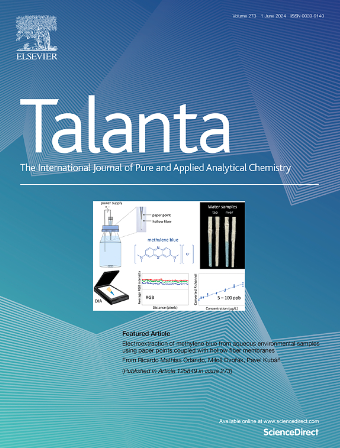Feasibility of laser-induced breakdown spectrometry for elemental mapping in fish-mint plant (Houttuynia cordata Thunb.) leaves exposed to iron
IF 6.1
1区 化学
Q1 CHEMISTRY, ANALYTICAL
引用次数: 0
Abstract
Laser-induced breakdown spectroscopy (LIBS) emerges as a rapid, direct analysis method requiring minimal or no sample preparation. In plant science, LIBS adds another interesting applicability, which is the possibility to obtain spatial distribution information through elemental mapping. Spatial distribution allows to verify the uptake, translocation and accumulation of elements in different plant parts, resulting in studies of metabolic pathways and phytotoxicity studies. In front of this, in this work, seedlings of Houttuynia cordata Thunb. (dokudami, or fish-mint plant) were exposed via foliar application to solution of 600 μg L−1 of Fe (Fe(NO3)3∙9H2O). The total concentration of Ca, Fe, K, and Mg in the control and Fe-exposed leaves were determined by ICP OES after digestion using microwave oven and diluted oxidant mixture. The elemental mapping by LIBS covered the entire abaxial surface of the leaf with 1.5 mm of distance between the ablation points, considering a predefined point-to-point pattern. The emission intensities in each region were used to elemental mapping construction. The emission intensity of C (247.856 nm) was applied as a correction standard. The Fe exposition promoted the Ca and K accumulation, while reducing Mg levels. The elemental variation was observed by LIBS mapping, revealing applicability in biological, as well as nutritional and toxicity studies.

激光诱导击穿光谱法在鱼薄荷植物(鱼腥草cordata Thunb.)暴露于铁中的可行性
激光诱导击穿光谱(LIBS)是一种快速,直接的分析方法,需要很少或不需要样品制备。在植物科学中,LIBS增加了另一个有趣的应用,即通过元素映射获得空间分布信息的可能性。空间分布可以验证元素在植物不同部位的吸收、转运和积累,从而研究代谢途径和植物毒性。在这面前,在这幅作品中,鱼腥草的幼苗。通过叶面施用于600 μg L−1的Fe(Fe(NO3)3∙9H2O)溶液中。采用微波消解和稀释氧化剂消解后的ICP OES法测定对照叶和铁暴露叶中Ca、Fe、K、Mg的总浓度。考虑到预定义的点对点模式,LIBS的元素映射覆盖了叶片的整个背面,消融点之间的距离为1.5 mm。利用各区域的辐射强度进行元素映射。采用C的发射强度(247.856 nm)作为校正标准。铁处理促进了钙和钾的积累,降低了镁的含量。通过LIBS图谱观察到元素变化,揭示了在生物学、营养和毒性研究中的适用性。
本文章由计算机程序翻译,如有差异,请以英文原文为准。
求助全文
约1分钟内获得全文
求助全文
来源期刊

Talanta
化学-分析化学
CiteScore
12.30
自引率
4.90%
发文量
861
审稿时长
29 days
期刊介绍:
Talanta provides a forum for the publication of original research papers, short communications, and critical reviews in all branches of pure and applied analytical chemistry. Papers are evaluated based on established guidelines, including the fundamental nature of the study, scientific novelty, substantial improvement or advantage over existing technology or methods, and demonstrated analytical applicability. Original research papers on fundamental studies, and on novel sensor and instrumentation developments, are encouraged. Novel or improved applications in areas such as clinical and biological chemistry, environmental analysis, geochemistry, materials science and engineering, and analytical platforms for omics development are welcome.
Analytical performance of methods should be determined, including interference and matrix effects, and methods should be validated by comparison with a standard method, or analysis of a certified reference material. Simple spiking recoveries may not be sufficient. The developed method should especially comprise information on selectivity, sensitivity, detection limits, accuracy, and reliability. However, applying official validation or robustness studies to a routine method or technique does not necessarily constitute novelty. Proper statistical treatment of the data should be provided. Relevant literature should be cited, including related publications by the authors, and authors should discuss how their proposed methodology compares with previously reported methods.
 求助内容:
求助内容: 应助结果提醒方式:
应助结果提醒方式:


